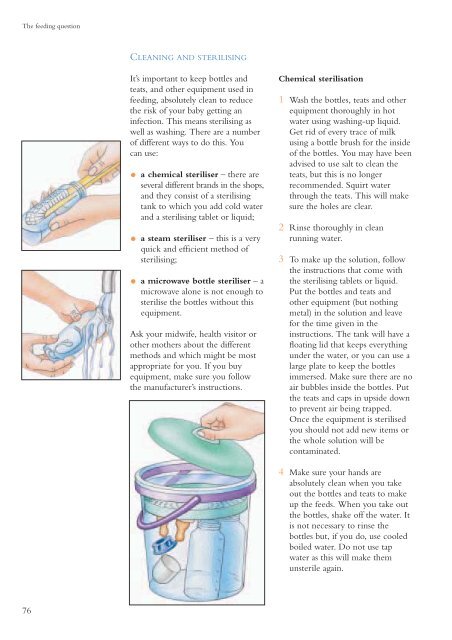here - Health Promotion Agency
here - Health Promotion Agency
here - Health Promotion Agency
Create successful ePaper yourself
Turn your PDF publications into a flip-book with our unique Google optimized e-Paper software.
The feeding question<br />
CLEANING AND STERILISING<br />
It’s important to keep bottles and<br />
teats, and other equipment used in<br />
feeding, absolutely clean to reduce<br />
the risk of your baby getting an<br />
infection. This means sterilising as<br />
well as washing. T<strong>here</strong> are a number<br />
of different ways to do this. You<br />
can use:<br />
•<br />
a chemical steriliser – t<strong>here</strong> are<br />
several different brands in the shops,<br />
and they consist of a sterilising<br />
tank to which you add cold water<br />
and a sterilising tablet or liquid;<br />
•<br />
a steam steriliser – this is a very<br />
quick and efficient method of<br />
sterilising;<br />
•<br />
a microwave bottle steriliser – a<br />
microwave alone is not enough to<br />
sterilise the bottles without this<br />
equipment.<br />
Ask your midwife, health visitor or<br />
other mothers about the different<br />
methods and which might be most<br />
appropriate for you. If you buy<br />
equipment, make sure you follow<br />
the manufacturer’s instructions.<br />
Chemical sterilisation<br />
1 Wash the bottles, teats and other<br />
equipment thoroughly in hot<br />
water using washing-up liquid.<br />
Get rid of every trace of milk<br />
using a bottle brush for the inside<br />
of the bottles. You may have been<br />
advised to use salt to clean the<br />
teats, but this is no longer<br />
recommended. Squirt water<br />
through the teats. This will make<br />
sure the holes are clear.<br />
2 Rinse thoroughly in clean<br />
running water.<br />
3 To make up the solution, follow<br />
the instructions that come with<br />
the sterilising tablets or liquid.<br />
Put the bottles and teats and<br />
other equipment (but nothing<br />
metal) in the solution and leave<br />
for the time given in the<br />
instructions. The tank will have a<br />
floating lid that keeps everything<br />
under the water, or you can use a<br />
large plate to keep the bottles<br />
immersed. Make sure t<strong>here</strong> are no<br />
air bubbles inside the bottles. Put<br />
the teats and caps in upside down<br />
to prevent air being trapped.<br />
Once the equipment is sterilised<br />
you should not add new items or<br />
the whole solution will be<br />
contaminated.<br />
4 Make sure your hands are<br />
absolutely clean when you take<br />
out the bottles and teats to make<br />
up the feeds. When you take out<br />
the bottles, shake off the water. It<br />
is not necessary to rinse the<br />
bottles but, if you do, use cooled<br />
boiled water. Do not use tap<br />
water as this will make them<br />
unsterile again.<br />
76
















